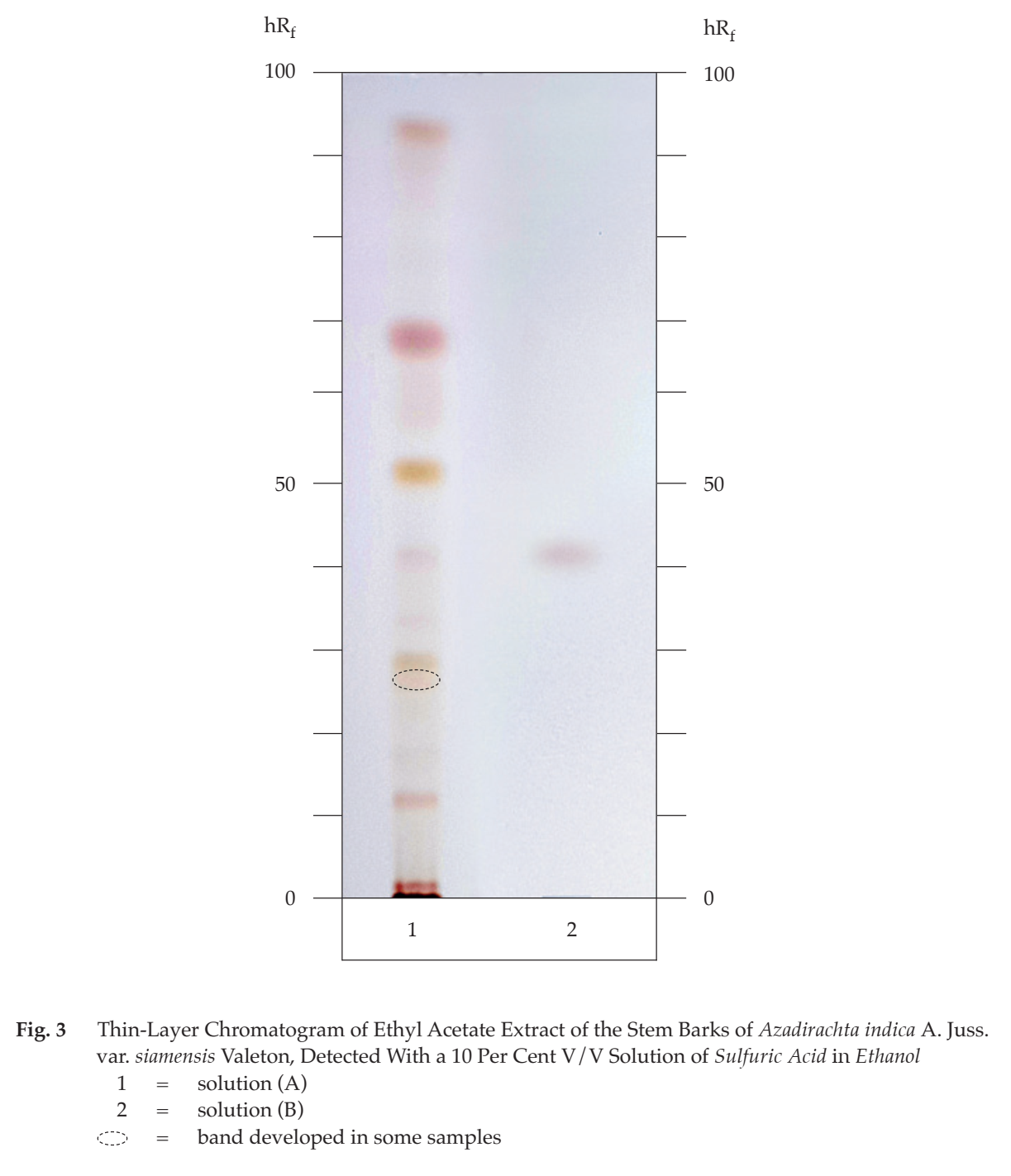ตำรามาตรฐานยาสมุนไพรไทย
Thai Herbal Pharmacopoeia
สำนักยาและวัตถุเสพติด กรมวิทยาศาสตร์การแพทย์ กระทรวงสาธารณสุข
Bureau of Drug and Narcotic, Department of Medical Sciences, Ministry of Public Health(Tinospora crispa (L.) Hook.f. & Thomson)
(Nelumbo nucifera Gaertn.)
(Centella asiatica (L.) Urb.)
(Centella Dry Extract)
(Centella Cream)
(Mesua ferrea L.)
(Piper sarmentosum Roxb.)
(Piper sarmentosum Roxb.)
(Pterocarpus santalinus L. f.)
(Santalum album L.)
(Senna tora (L.) Roxb.)
(Senna alata (L.) Roxb.)
(Senna Alata Tea)
(Piper retrofractum Vahl)
(Myristica fragrans Houtt)
(Andrographis paniculata (Burm. f.) Nees)
(Andrographis Capsules)
(Allium ascalonicum L.)
(Ocimum tenuiflorum L.)
(Curcuma longa L.)
(Turmeric Capsules)
(Turmeric Dry Extract)
(Turmeric Dry Extract Capsules)
(Arcangelisia flava (L.) Merr.)
(Curcuma sp.)
Harrisonia perforata (Blanco) Merr.
(Aristolochia pierrei Lecomte)
(Zingiber officinale Roscoe)
(Ginger Capsules)
(Ginger Tea)
(Cassia fistula L.)
(Nardostachys jatamansi (D. Don) DC.)
(Angelica sinensis (Oliv.) Diels)
Artemisia annua L.
(Ligusticum sinense Oliv. cv. Chuanxiong)
(Neopicrorhiza scrophulariiflora Pennell)
(Atractylodes lancea (Thunb.) DC.)
(Aucklandia lappa Decne)
(Terminalia chebula Retz.)
(Angelica dahurica (Hoffm.) Benth. & Hook. f. ex Franch. & Sav. var. dahurica)
(Kaempferia parviflora Wall. ex Baker)
(Hibiscus sabdariffa L.)
(Roselle Tea)
(Allium sativum L.)
(Zingiber zerumbet (L.) Sm.)
(Wurfbainia testacea (Ridl.) Škorničk.& A. D. Poulsen)
(Cannabis sativa L.)
(Myristica fragrans Houtt)
(Dracaena cochinchinensis (Lour.) S. C. Chen)
(Ficus racemosa L.)
(Hyptis suaveolens (L.) Poit.)
Clerodendrum indicum (L.) Kuntze
(Phyllanthus emblica L.)
(Citrus hystrix DC.)
(Citrus hystrix DC.)
(Areca catechu L.)
(Momordica charantia L.)
Moringa oleifera Lam.
(Aegle marmelos (L.) Corrêa)
(Solanum trilobatum L.)
(Morus alba L.)
Gynostemma pentaphyllum(Thunb.)
Makino
(Clinacanthus nutans (Burm. f.) Lindau)
(Cissus quadrangularis L.)
(Mimusops elengi L.)
(Zingiber montanum (J. König) Link. ex A. Dietr.)
(Piper betle L.)
(Capsicum annuum L.)
(Capsicum Oleoresin)
(Capsicum Gel)
(Piper nigrum L.)
(Piper nigrum L.)
(Eurycoma longifolia Jack)
(Thunbergia laurifolia Lindl.)
(Piper wallichii (Miq.) Hand.-Mazz.)
Senna garrettiana (Craib) H. S. Irwin & Barneby
(Terminalia bellirica (Gaertn.) Roxb.)
(Terminalia chebula Retz.)
(Caesalpinia bonduc (L.) H. Roxb.)
(Tarlmounia elliptica (DC.) H. Rob., S. C. Keeley, Skvaria & R. Chan)
(Hog Creeper Vine Dry Extract Capsiles)
(Hog Creeper Vine Dry Extract)
(Brachypterum scandens (Roxb.) Miq.)
(Lepidium sativum L.)
(Nigella sativa L.)
(Cuminum cyminum L.)
(Foeniculum vulgare Mill.)
(Plantago ovata Forssk.)
(Pimpinella anisum L.)
(Carum carvi L.)
(Anethum graveolens L.)
(Trachyspermum ammi (L.) Sprague)
Albizia procera (Roxb.) Benth.
(Acorus calamus L.)
(Tiliacora triandra (Colebr.) Diels)
Cyanthillium cinereum (L.) H. Rob.
(Orthosiphon aristatus (Blume) Miq.)
Murdannia loriformis (Hassk.) R. S. Rao & Kammathy
(Capparis micracantha DC.)
(Chrysopogon zizanioides (L.) Roberty)
(Cyperus rotundus L.)
(Cannabis sativa L.)
(Syzygium aromaticum (L.) Merr. & L. M. Perry)
(Boesenbergia rotunda (L.) Mansf.)
(Acanthus ebracteatus Vahl)
(Acanthus ilicifolius L.)
(Kaempferia galanga L.)
(Curcuma comosa Roxb.)
Betula alnoides Buch.-Ham. ex D. Don
Cannabis sativa L.
Carthamus tinctorius L
Mitragyna speciosa (Korth.) Havil
Mallotus repandus (Rottler) Müll. Arg
Azadirachta indica A. Juss. var. siamensis Valeton
Azadirachta indica A. Juss. var. siamensis Valeton
Punica granatum L.
Rhinacanthus nasutus (L.) Kurz
Baliospermum solanifolium (Burm.) Suresh
Curcuma aeruginosa Roxb
Boesenbergia kingii Mood & L. M. Prince
Senegalia rugata (Lam.) Britton & Rose
Acacia concinna (Willd.) DC.
Senegalia rugata (Lam.) Britton & Rose
Acacia concinna (Willd.) DC.
Senna alexandriana Mill. var. alexandriana
Cassia acutifolia Delile, Cassia angustifolia Vahl
Butea superba Roxb. ex Willd.
[Plaso superba (Roxb. ex Willd.) Kuntze, Rudolphia superba (Roxb. ex Willd.) Poir.
Pueraria candollei Graham
ex Benth. var. mirifica (Airy Shaw & Suvat.) Niyomdham
Streblus asper Lour.
Suregada multiflora (A. Juss.) Baill. (Gelonium
multiflorum A. Juss.
Plumbago zeylanica L.
Plumbago indica L.
Biancaea sappan (L.) Tod.
Ziziphus attopensis Pierre
Streblus asper Lour.
Justicia gendarussa Burm. f.
Enhalus acoroides (L. f.) Royle
Bridelia ovata Decne.
Tamarindus indica L.
Citrus × aurantiifolia (Christm.) Swingle
Garcinia mangostana L.
Blumea balsamifera (L.) DC
Persicaria odorata (Lour.) Soják
Zingiber montanum (J. König) Link ex A. Dietr.
Mammea siamensis (Miq.) T. Anderson
Citrus maxima (Burm.) Merr.
Citrus × aurantium L. ‘Som Sa’
Punica granatum L.
Rhinacanthus nasutus (L.) Kurz
Siamese Neem Bark is the dried stem bark of Azadirachta indica A. Juss. var. siamensis Valeton (Family Meliaceae), Herbarium Specimen Number: DMSC 5311, Crude Drug Number: DMSc 1231.
Constituents Siamese Neem Bark contains tetranortriterpenoids (e.g., nimbin and 6-deacetylnimbin) and phenolics (e.g., catechin and epicatechin).
Description of the plant (Fig. 1) Evergreen tree, up to 20 m tall; bark greyish brown, vertically striated. Leaves pinnately compound, spirally arranged, young leaves usually reddish; exstipulate; rachis 20 to 40 cm long; petiole 6 to 14 cm long, slender, swollen at base; leaflets 6 to 12 pairs, opposite or subopposite, leaflet at tip sometimes reduced; exstipellate; petiolule 4 to 7 mm long, slender, glabrous; lamina oblanceolate or broadly falcate, 6.5 to 12.5 cm long, 2.1 to 5.2 cm wide, apex acuminate, base oblique, margin serrate or serrateundulate, coriaceous, glabrous, lateral nerves 8 to 13 pairs, slender, prominent, veinlets reticulate, fainted. Inflorescence panicle, axillary or terminal, up to 30 cm long, appear before leaves. Flower white, bisexual, 1 to 1.5 cm in diameter; bracteole scaly; pedicel about 2 mm long; sepals 5, free, ovate; petals 5, free, obovate-oblong, hairy, imbricate in bud; stamens 10, connated into cylindrical staminal tube, about 6 mm long, terminally 10-lobed, glabrous outside, inside pubescent, anthers 10, attached at base of lobes inside, slightly exserted; ovary superior, globose, 3-loculed, ovules 2 per locule, placentation axile, style slender, elongate, stigma slightly 3-lobed. Fruit a drupe, oblong-ovoid, 1.5 to 2 cm long, 0.5 to 1 cm wide, green when young, yellow when ripe, shiny. Seeds 1 or 2.
Description Odour, unpleasantly characteristic; taste, bitter.
Macroscopical (Fig. 1) Irregular pieces of stem bark, varying in shape and size, mostly curved, hard; externally greyish brown to dark brown, rough, irregularly cracked; internally yellowish brown to reddish brown, with fine longitudinal striations.
Microscopical (Figs. 2a, 2b) Transverse section of the stem bark shows periderm and phloem tissue. Periderm: lenticels, rectangular cork cells with brown substance and groups of sclereids some containing reddish brown to brown substance. Phloem tissue: polygonal parenchyma some containing starch grains or prismatic crystals, groups of sclereids some containing reddish brown to brown substance, bast fibres some containing prismatic crystals, and phloem rays.
Siamese Neem Bark in powder possesses the diagnostic microscopical characters of the unground drug. Rectangular cork cells with reddish brown to brown substance, sclereids containing reddish brown to brown substance, phloem rays containing starch grains, and fibres with prismatic sheath are characteristic.
Packaging and storage Siamese Neem Bark shall be kept in well-closed containers, protected from light, and stored in a dry place.
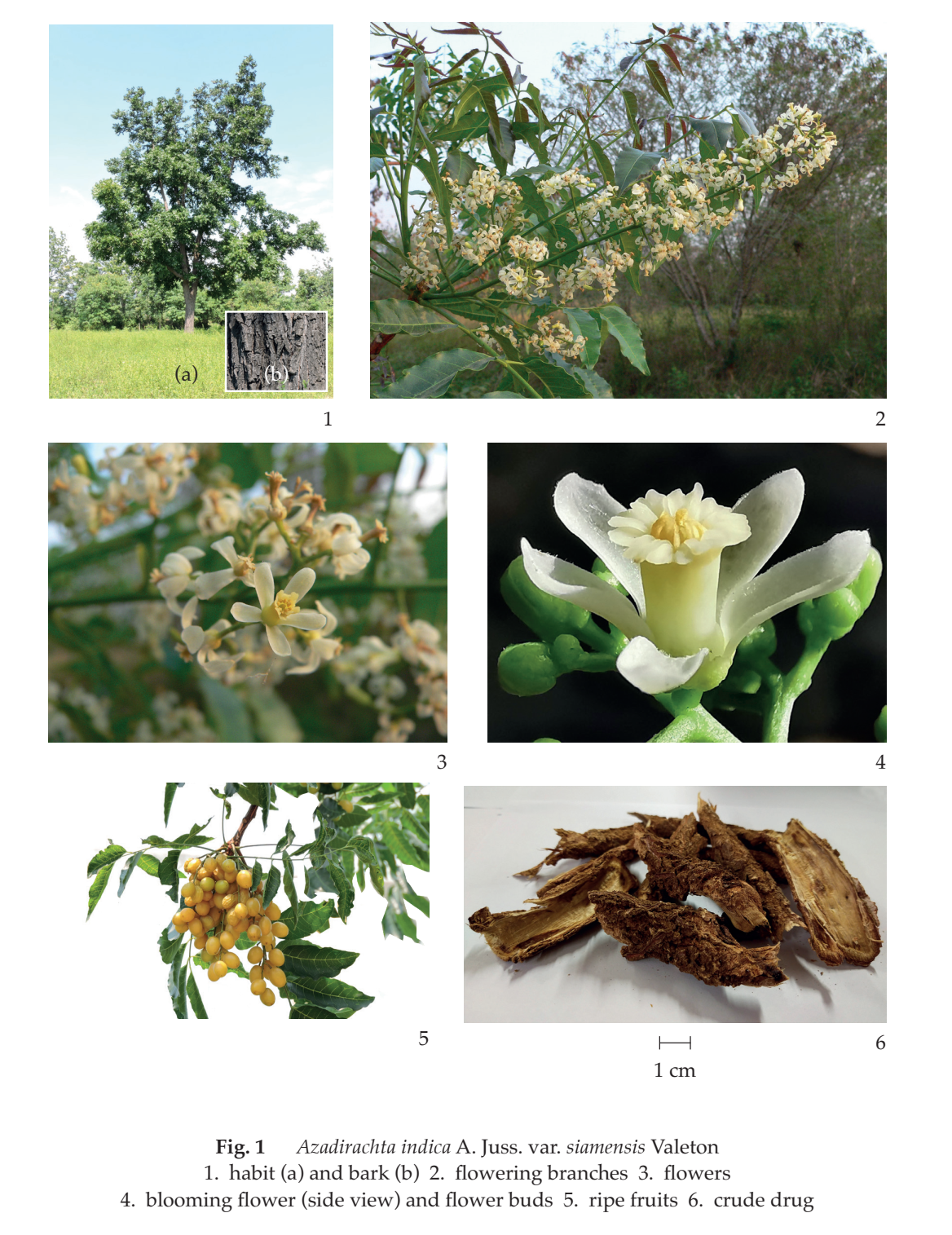
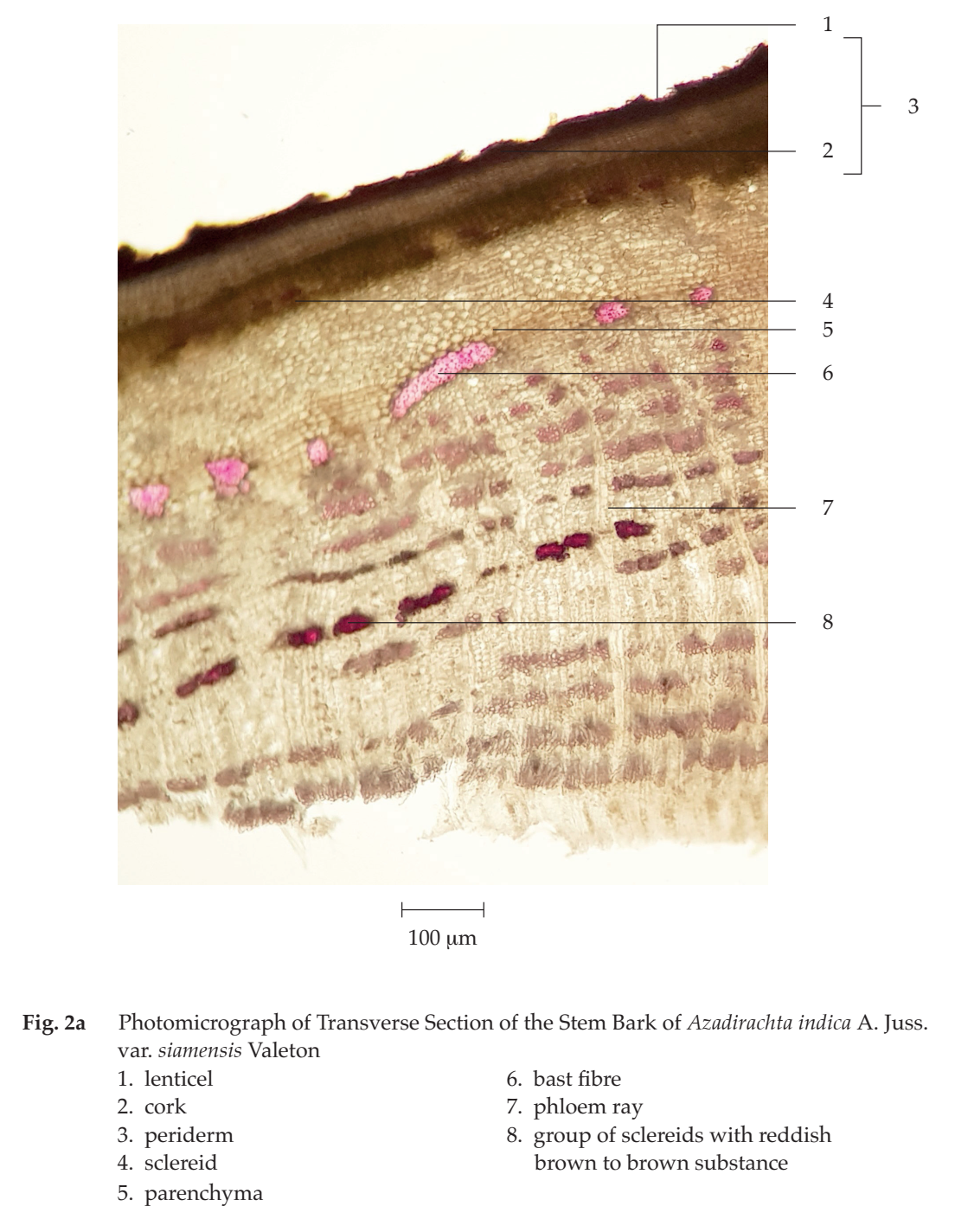
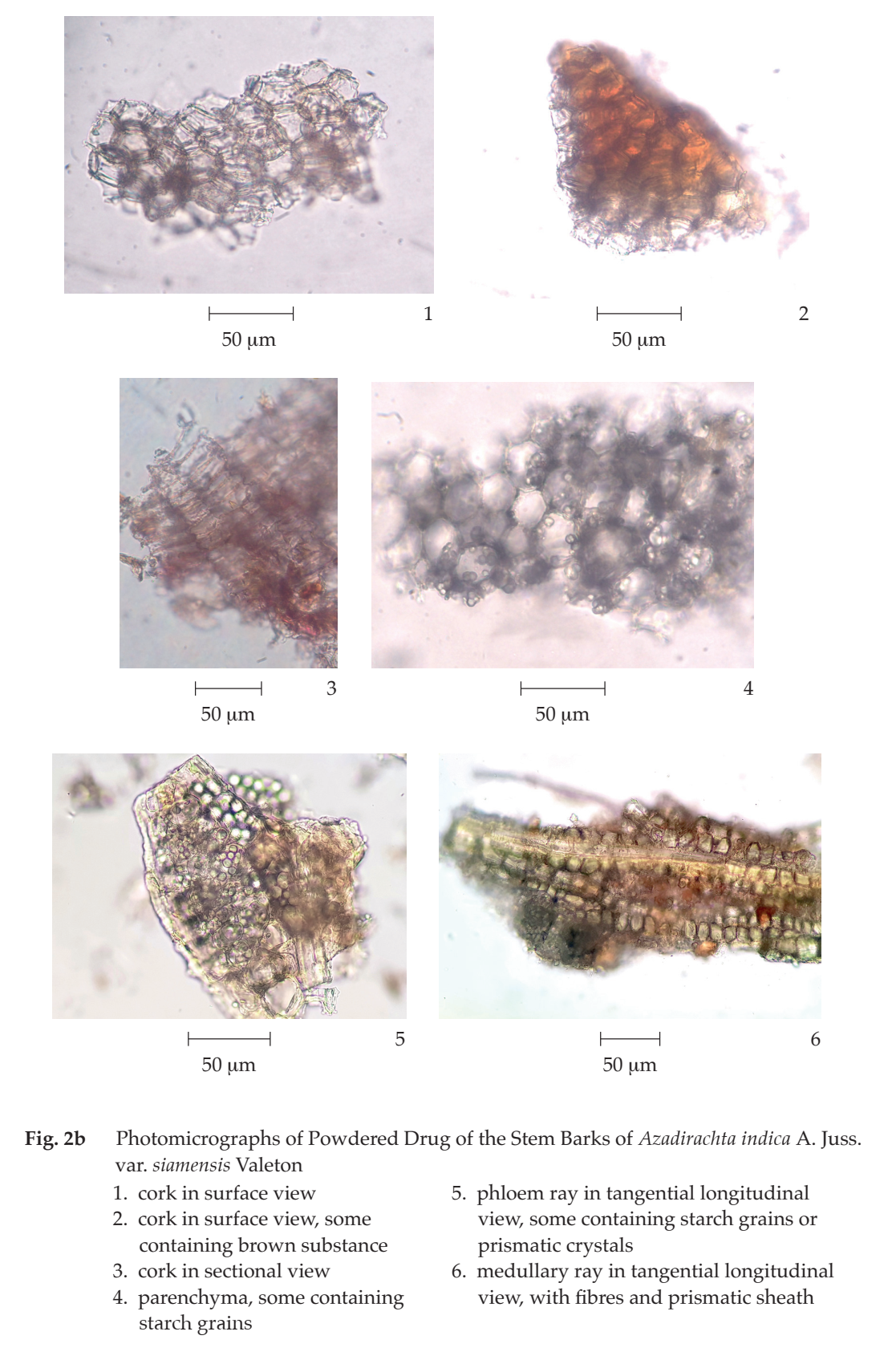
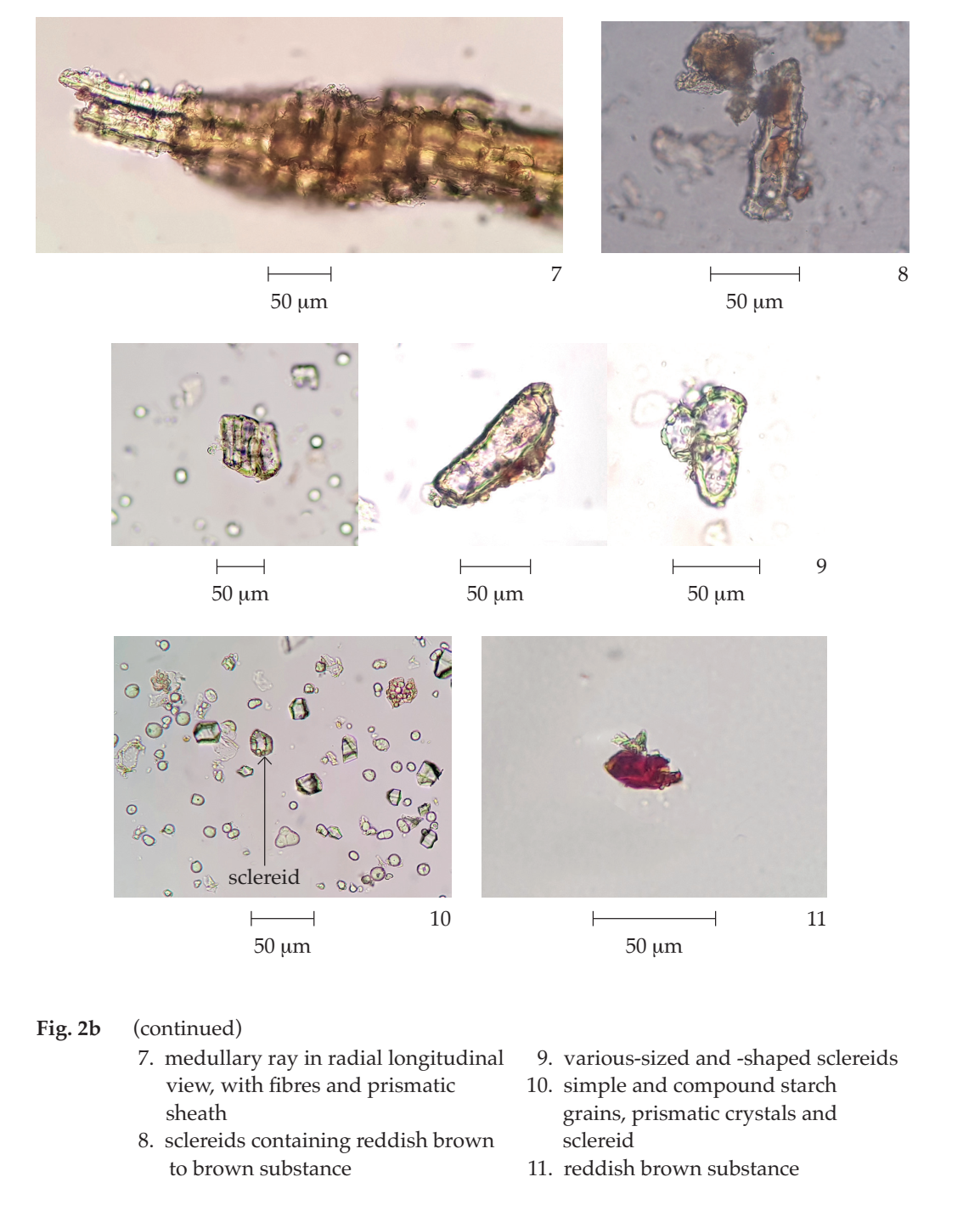
Identification
A. Reflux 2 g of the sample, in fine powder, with 20 mL of ethyl acetate for 1 hour and filter (solution 1). Evaporate 5 mL of solution 1 to dryness and dissolve the residue in a few drops of acetic anhydride. Add slowly a few drops of sulfuric acid: a reddish brown colour is produced.
B. Carry out the test as described in the “Thin-Layer Chromatography” (Appendix 3.1), using silica gel 60 F254 as the coating substance and a mixture of 49 volumes of hexane, 49 volumes of ethyl acetate, and 2 volumes of methanol as the mobile phase and allowing the solvent front to ascend 10 cm above the line of application. Apply separately to the plate as bands of 8 mm, 10 µL each of solutions (A) and (B). Prepare solution (A) by evaporating 5 mL of solution 1 to dryness and dissolve the residue in 1 mL of dichloromethane. For solution (B) dissolve 1 mg of 6-deacetylnimbin in 1 mL of dichloromethane. After removal of the plate, allow it to dry in air and spray with a 10 per cent v/v solution of sulfuric acid in ethanol and heat at 110° for 5 minutes; the band due to 6-deacetylnimbin is brownish black (hRf value about 40). One pink and five brown bands are observed (Fig. 3).
Loss on drying Not more than 10.0 per cent w/w after drying at 105° to constant weight (Appendix 4.15).
Foreign matter Not more than 2.0 per cent w/w (Appendix 7.2).
Total ash Not more than 12.0 per cent w/w (Appendix 7.7).
Ethanol-soluble extractive Not less than 3.0 per cent w/w (Appendix 7.12).
Water-soluble extractive Not less than 5.0 per cent w/w (Appendix 7.12)
